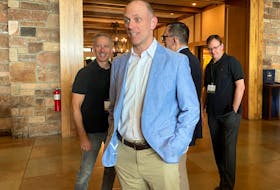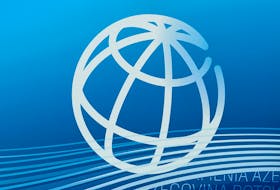
An oiled, thick-billed murre in Cripple Cove, near Cape Race.
If you want to know what’s going on around the offshore platforms, the monitoring system relied upon by the Canada-Newfoundland and Labrador Offshore Petroleum Board (CNLOPB) and other regulators is not producing enough useful information, according to a new report from researchers with York University in Toronto.
RELATED STORIES
Aiming to avoid spills (From a 2012 series on the CNLOPB)
Independent observers not needed despite calls for them: official (2012)
The report from Gail Fraser and Vincent Racine from the faculty of environmental studies acknowledges offshore oil projects are not the only source of pollutants and “perhaps proportionally a lower source of seabird mortality compared to other sources,” but a source nonetheless.
Given declining seabird populations worldwide, they state, it is important to look into all potential sources of seabird deaths.
Fraser and Racine reviewed spill reports from oil companies in Newfoundland and Labrador’s offshore area — for the Hibernia, Terra Nova and White Rose operations. They used the access to information system to obtain reports submitted to the CNLOPB in the years 1997 to 2010. The data was then reviewed over the course of about five years.
The pair zeroed in on spills under 7.95 cubic metres (one cubic metre is equal to 1,000 litres) and involving anything from crude oil to diesel to drilling muds.
In all, 381 spills of size were reported, they stated. But of those reports, only 17 included observations on seabirds.
Reporting was inconsistent in terms of other details, they added, including time of day, wave heights and weather.
“As a result of the lack of data, future production environmental impact statement predictions will not be informed by previous experience and a weak environmental assessment process is perpetuated,” they noted.
The regulator has moved to standardize reporting, it states, but — at least as of 2010 — did not demand comments specifically on seabirds in the written reports.
“I do think progress has been made in disclosing important environmental data,” Fraser said, speaking with The Telegram Thursday.
However, she added, a lack of consistent and high-quality data is holding back the study of how seabirds interact with offshore oil operations.
“Right now we are no better off than what we were when Hibernia went through environmental assessment in 1985, in understanding chronic oil pollution on seabirds. We don’t know anything,” she said.
“We’ve relied on self-reporting. And it’s just not working.”
The York University study was supported by funding from the Social Science and Humanities Research Council Strategic Research Grant of Canada.
Memorial University research professor and bird specialist Bill Montevecchi has a trio of papers cited within the report.
“It just essentially bears witness to decades of self-reporting by the oil industry,” he said, contacted following publication in the latest edition of the Marine Pollution Bulletin.
He challenged the CNLOPB’s position in not installing environmental observers on platforms or demanding more environmental research, referring to the report’s findings.
“The regulator does not regulate,” he said.
Apart from spills, scientists including Montevecchi want to know more about light emissions from offshore installations and what they mean to large populations of seabirds feeding in and travelling through Newfoundland and Labrador’s offshore area.
“If we had observers there, yes, we could document that and yes, we could offer mitigation strategies,” he said. “The fact of the matter is we know nothing.”
At the Canadian Association of Petroleum Producers, Paul Barnes had yet to see the report, but said operators off Newfoundland and Labrador all have programs for observing birds, including daily monitoring. Observers, he noted, are trained by the Canadian Wildlife Service and carry out their duties in addition to other platform duties.
As for the addition of independent observers?
“The offshore facilities are industrial worksites, built for purpose and for safety reasons do not have extraneous personnel on board,” he stated.
The Telegram has been in contact with the CNLOPB. The regulator is reviewing the report.








